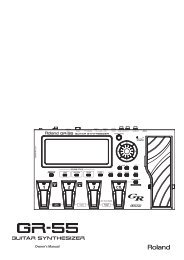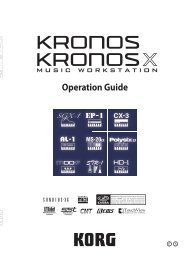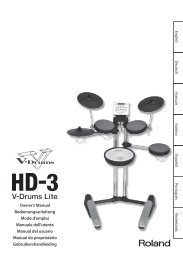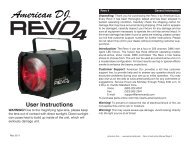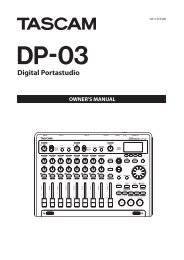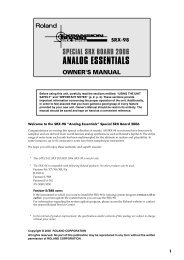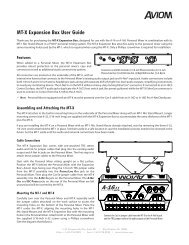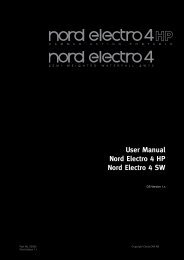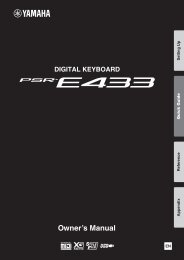Korg Microkorg Owner's Manual - zZounds.com
Korg Microkorg Owner's Manual - zZounds.com
Korg Microkorg Owner's Manual - zZounds.com
Create successful ePaper yourself
Turn your PDF publications into a flip-book with our unique Google optimized e-Paper software.
6. FILTER — SYNTH<br />
The filter controls the tonal character of the sound produced by the oscillator. It determines the tone by allowing only the desired portion of<br />
the sound to pass. "TYPE" (knob 1) selects the type of filter (i.e., the way in which it will cut the frequency). "CUTOFF" (knob 2) sets the<br />
frequency at which the cut will occur. Normally, turning this knob toward the right will brighten the sound, and turning it toward the left<br />
will darken the sound. "RESONANCE" (knob 3) emphasizes the frequency region near the cutoff frequency, adding a distinctive character to<br />
the sound. Other parameters in this section let you specify the depth of the modulation applied by the filter EG, and the way in which<br />
keyboard tracking will affect the cutoff frequency.<br />
24<br />
TYPE<br />
[-24dB LPF, -12dB LPF,<br />
-12dB BPF, -12dB HPF]<br />
Selects the type of filter<br />
-24dB LPF ( ):<br />
The -24 dB LPF (-24 dB/octave Low<br />
Pass Filter) is the most <strong>com</strong>mon<br />
type of filter; it passes the frequencies<br />
that are below the cutoff frequency,<br />
and cuts the frequencies<br />
that are above (➝Figure 6-1). Lowering<br />
the cutoff frequency will<br />
make the tone darker and more<br />
mellow.<br />
-12dB LPF ( ):<br />
The -12 dB LPF (-12 dB/octave Low<br />
Pass Filter) has a more gentle slope<br />
than the -24 dB LPF, producing a<br />
more natural-sounding effect.<br />
(➝"-24 dB LPF")(➝Figure 6-1)<br />
Figure 6-1<br />
LPF (Low Pass Filter)<br />
Cutoff<br />
-12dB/oct<br />
-24dB/oct<br />
Frequency<br />
CUTOFF [0...127]<br />
Sets the cutoff frequency.<br />
Increasing this value will raise the<br />
cutoff frequency.<br />
"CUTOFF" can be varied by<br />
time-variant change produced<br />
by Filter EG, by keyboard playing<br />
dynamics (velocity), and by<br />
note location (keyboard tracking).<br />
If the "CUTOFF" value is set too<br />
low, the volume may be extremely<br />
low, or you may hear no<br />
sound at all.<br />
Figure 6-4<br />
The effect of resonance<br />
LPF<br />
HPF<br />
BPF<br />
Low resonance value<br />
RESONANCE [0...127]<br />
Sets the resonance of the filter.<br />
This will emphasize the overtones<br />
near the cutoff frequency specified<br />
by "CUTOFF," adding a distinctive<br />
character to the sound. Increasing<br />
this value will increase the effect.<br />
(➝Figure 6-4)<br />
Since movement of the "CUTOFF"<br />
knob will affect the overtones that<br />
are boosted by resonance, it is best<br />
to adjust "CUTOFF" and "RESO-<br />
NANCE" in conjunction with each<br />
other.<br />
High resonance value<br />
FILTER EG INT [-63...63]<br />
This specifies how time-variant<br />
modulation from the Filter EG will<br />
be applied to the cutoff frequency<br />
(➝Figure 6-5). The cutoff frequency<br />
will change over time according to<br />
the Filter EG settings, modifying<br />
the tone. For example, you can use<br />
this to create a sound that gradually<br />
begins to brighten when you<br />
press the key, and then gradually<br />
be<strong>com</strong>es darker.<br />
This INT (Intensity) parameter<br />
specifies the depth (sensitivity) to<br />
which the Filter EG will affect the<br />
cutoff frequency.<br />
With a setting of 0, the Filter EG will<br />
not affect the cutoff frequency. Increasingly<br />
positive (+) settings will<br />
allow the Filter EG to have a correspondingly<br />
greater effect on the<br />
cutoff frequency. (➝Figure 6-6)<br />
Increasingly negative (-) settings<br />
will allow a correspondingly<br />
greater effect in the opposite direction.<br />
(➝Figure 6-7)<br />
FILTER KEY TRACK [-63...63]<br />
This specifies how keyboard tracking<br />
(the keyboard location that you<br />
play) will affect the cutoff frequency.<br />
For example if the sound played by<br />
the C4 key has the desired tone but<br />
higher notes no longer have resonance<br />
or are too mellow-sounding,<br />
you can adjust keyboard tracking to<br />
make <strong>com</strong>pensations so that the<br />
cutoff frequency will rise for higher<br />
notes.<br />
With positive (+) settings, the cutoff<br />
frequency will rise as you play<br />
upward from the C4 note, and fall<br />
as you play downward. With negative<br />
(-) settings, the cutoff frequency<br />
will fall as you play upward from<br />
the C4 note, and rise as you play<br />
downward.<br />
With a setting of +48, the change<br />
in cutoff frequency will be proportionate<br />
to the change in<br />
pitch. With a setting of 0, keyboard<br />
tracking will not affect the<br />
cutoff frequency.



